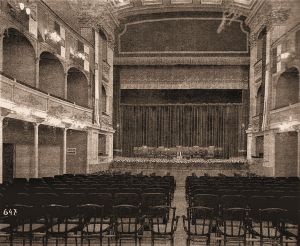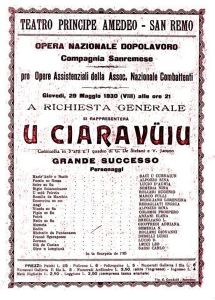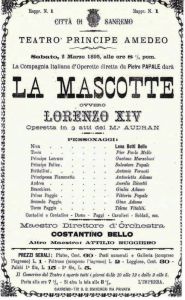A historic theatre that the madness of war has made disappear
Count Stefano Roverizio di Roccasterone was mayor of Sanremo on several occasions from 1844 to 1848, from 1850 to 1855 and finally from 1873 to 1875.
Especially in this last period, the city became an international health resort and underwent its great transformation through an enormous fervour of works as well as of life and society.
The development of tourist activities in the second half of the 19th century also led to the construction of new accommodation and recreational facilities to provide entertainment and recreation for the city's growing tourist clientele. 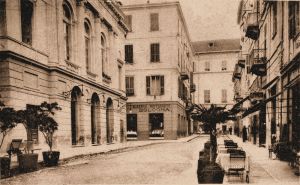 In order to meet this need, the municipal administrators, noting the total inadequacy of the old Chiarle theatre to hold all the city's and foreign spectators, decided to entrust the young Genoese architect Giacomo Grasso with the task of drawing up a project for the construction of a new and more spacious city theatre.
In order to meet this need, the municipal administrators, noting the total inadequacy of the old Chiarle theatre to hold all the city's and foreign spectators, decided to entrust the young Genoese architect Giacomo Grasso with the task of drawing up a project for the construction of a new and more spacious city theatre.
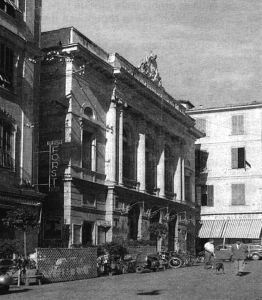 On 9 August 1875, architect Grasso delivered the project for the new theatre, which was completed on 14 November 1875 thanks to the hard work of the builder and construction manager Giuseppe Bissini.
On 9 August 1875, architect Grasso delivered the project for the new theatre, which was completed on 14 November 1875 thanks to the hard work of the builder and construction manager Giuseppe Bissini.
On 9 December 1875, Prince Amedeo of Savoy accepted the dedication of the new theatre and on 22 January 1876 it was solemnly inaugurated with the opening performances of Verdi's "Un ballo in maschera" and "Il Trovatore", Bellini's "Sonnambula" and Donizetti's "Poliuto", conducted by Maestro Francesco Della Ferrara.
The impresarios were Bissini, Sghirla, Margarini and Minoia.
The building, which cost about 200,000 lire, was in a severe, classical style, with a façade 16 metres high and 20 metres wide and a maximum depth of 40 metres. 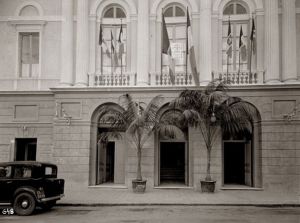 The main façade had three large windows surmounted by three wide doors leading to the stalls and the stairs to the boxes, which were flanked by two smaller doors, also surmounted by two smaller windows, one leading to the gallery and the other to the auditorium.
The main façade had three large windows surmounted by three wide doors leading to the stalls and the stairs to the boxes, which were flanked by two smaller doors, also surmounted by two smaller windows, one leading to the gallery and the other to the auditorium.
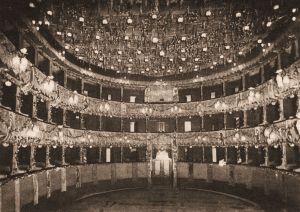 The large interior hall, in the traditional style, had a vast stalls, with five rows of upholstered benches and 56 velvet armchairs with a total capacity of 500 people, and a large stage, while on the upper floor were two more rows of boxes and'a large gallery for 400 people elegantly decorated with red silk tapestry.
The large interior hall, in the traditional style, had a vast stalls, with five rows of upholstered benches and 56 velvet armchairs with a total capacity of 500 people, and a large stage, while on the upper floor were two more rows of boxes and'a large gallery for 400 people elegantly decorated with red silk tapestry.
The theatre was also adorned, both inside and out, with fine stucco work by the Baglioni family. The frescoes in the foyer, the foyer and the auditorium were the work of the Genoese decorative painter Giovanni Novaro, while the cur because of the scenes were made by the latter's brother, Giovanni Battista Novaro.
However, the building underwent some changes in 1913 when it was restructured according to the project of the architect Carlo Gastaldi and in 1943 it even changed its original name from "Principe Amedeo" to "Giuseppe Verdi".
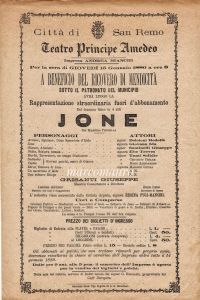
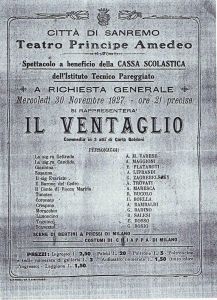 During the first thirty years of its activity, the Principe Amedeo hosted many theatrical works of great calibre, counting among its public illustrious and high-ranking names, among whom we can remember the German Crown Prince Federico Guglielmo, who went to see a show's performance at the Principe Amedeo during his short stay in Sanremo in the winter season 1887-88.
During the first thirty years of its activity, the Principe Amedeo hosted many theatrical works of great calibre, counting among its public illustrious and high-ranking names, among whom we can remember the German Crown Prince Federico Guglielmo, who went to see a show's performance at the Principe Amedeo during his short stay in Sanremo in the winter season 1887-88.
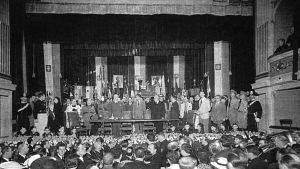
 Not only theatrical performances, but it was also used for political conventions during the twenty years of Fascism and for special celebrations.
Not only theatrical performances, but it was also used for political conventions during the twenty years of Fascism and for special celebrations.
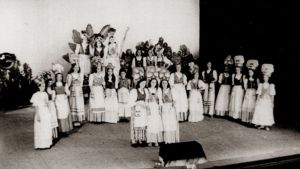 Later, however, due to competition from the newly-established Teatro del Casinò, the Principe Amedeo would experience a period of crisis destined to last at least until the outbreak of World War II, when the simultaneous closure of the Teatro del Casinò gave new prestige to the historic theatre in Matuzia.
Later, however, due to competition from the newly-established Teatro del Casinò, the Principe Amedeo would experience a period of crisis destined to last at least until the outbreak of World War II, when the simultaneous closure of the Teatro del Casinò gave new prestige to the historic theatre in Matuzia.
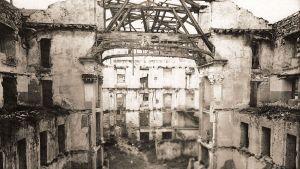 In
In 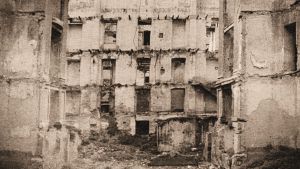 August 1944 a bombing seriously damaged the building, which was finally demolished after the war.
August 1944 a bombing seriously damaged the building, which was finally demolished after the war.
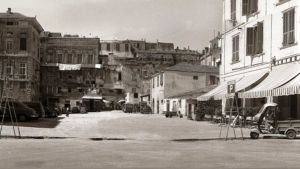 Once cleared of rubble, in its place was an open space which, over the years, has been used in many ways, including as a car park. Until today, when, revalued, it has taken the name of Piazza Borea d'Olmo (from the name of the Palazzo in the background) and has been used for various public events.
Once cleared of rubble, in its place was an open space which, over the years, has been used in many ways, including as a car park. Until today, when, revalued, it has taken the name of Piazza Borea d'Olmo (from the name of the Palazzo in the background) and has been used for various public events.
(sources: free elaboration from texts by Andrea Gandolfo and Roberto Colombo; images from private archive)





